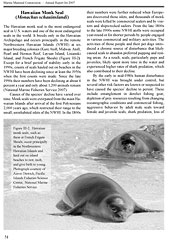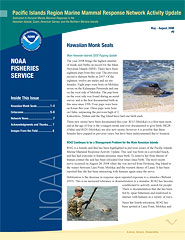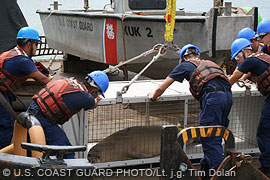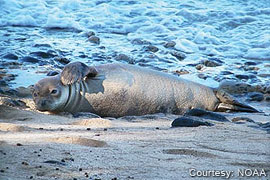


 |  | |
 | ||
Vol. 12 (1): June 2009 | ||
Ecosystem healthy; monk seals plunging
NOAA’s Office of National Marine Sanctuaries released a 54-page report in March, concluding that marine life and habitats at the Papahānaumokuākea Marine National Monument remain in good-to-fair overall condition, but face both existing and emerging threats. Encompassing 139,792 square miles of the Pacific Ocean – an area larger than all the country’s national parks combined, the North Western Hawaiian Islands have been called a “significant contributor” to marine biological diversity. Thanks to their isolation, as well as past management efforts, the reefs of the NWHI, the reports states, can be considered as being in near-pristine condition. However, past impacts, the report states, such as military activities resulting in contamination of many atolls, have led to permanent alteration and some degradation of habitats. Significant and ongoing threats to wildlife, including Hawaiian monk seals and sea birds, include derelict fishing gear and marine debris. Coral bleaching is also cited as a problem, tying in with recent rises in sea temperatures. Emerging threats cited in the report include global climate change, rising sea levels, and ocean acidification. “Much of the current beach habitats that are monk seal resting places and sea turtle nesting habitat,” the report finds, “may be greatly diminished or lost altogether with sea level rise.” While most wild “living resource” populations in the monument appear to be in healthy condition, the report cautions, “monk seals are significantly decreasing.” Continuing uncertainty over the precise or inter-relating causes of the monk seal’s increasingly alarming decline has spawned an intense research effort, as management interventions, such as the removal of sharks targeting pups, and relocation in an effort to improve survivorship, continue. A closer reading of the report indicates just what dire straits the Hawaiian monk seal currently finds itself, as well as the implications posed by the lack of clear scientific knowledge surrounding the species’ precipitous decline. Among other observations, the report declares that:
The report goes on to express the hope that National Marine Fisheries Service Recovery Plan for the Hawaiian Monk Seal will reverse such declines [see NOAA signs new Hawaiian Monk Seal Recovery Plan, TMG 10 (2): November 2007]. Further informationOffice of National Marine Sanctuaries. 2009. Papahānaumokuākea Marine National Monument Condition Report 2009. U.S. Department of Commerce, National Oceanic and Atmospheric Administration, Office of National Marine Sanctuaries, Silver Spring, MD: 1-54. [PDF NOAA. 2007. Recovery Plan for the Hawaiian monk seal (Monachus schauinslandi). Revised. National Marine Fisheries Service, National Oceanic and Atmospheric Administration: 1-165. [PDF
|
 | |
|
|
The Marine Mammal Commission’s Annual Report to Congress for 2007 was published in autumn last year. For those interested in Hawaiian monk seal population trends, human and natural threats to the species, as well as efforts underway to stem the species’ continuing decline, the MMC report remains the indispensable guide.
Among the new report’s findings:
While stressing that the Hawaiian monk seal is in serious crisis, it is the failure of some past management efforts in captive care that provide eye-opening reading in the 2007 assessment. According to the report:
Despite previous captive care incidents (for example, in 1995, when ten monk seals were blinded by an unknown illness while in captivity; and all twelve captured could never be released because of fears of contaminating the wild population), discussions are underway to establish a centralized captive care facility on the Main Hawaiian islands that could to handle initially 50 and, with expansion, even a 100 animals.
In the meantime, equipped with a significantly increased budget, as well as an approved management plan at the Papahānaumokuākea Marine National Monument, strenuous efforts are being made to achieve a successful implementation of the 2007 recovery plan for species.
Marine Mammal Commission. 2008. Annual Report to Congress 2007. Marine Mammal Commission, Bethesda, Maryland: 1-207. [PDF  6.4MB]
6.4MB]
Papahānaumokuākea Marine National Monument. Management Plan. 2008.
 | |
|
|
For those interested in marine mammal rescue, monitoring, monk seal pupping around the Main Hawaiian Islands, as well as efforts to limit human-seal interactions, NOAA Fisheries produces a periodic Activity Update on work carried out by the Pacific Islands Region Marine Mammal Response Network.
The most recent issue (May-August 2008) carries news of the 2008 pupping season on the Main Hawaiian Islands (the highest number of births on record), and efforts to deal with the problem monk seal RO42, which became habituated to humans and actively sought out their company. Evidence suggests that such behaviour, including feeding by speargun fishermen and interacting with swimmers, was progressively reinforced, despite the Response Network’s best efforts to mitigate it.
As conveyed in subsequent news reports (see News Watch, below), RO42 was later evacuated to the North Western Hawaiian Islands, where human interaction is likely to pose something of a problem, given its isolation.
For a full report on orphaned monk seal KP2, taken into care after being abandoned by his mother, please turn to this issue’s In Focus article by David Schofield.
NOAA. Marine Mammal Response, Pacific Islands Regional Office, NOAA Fisheries.
NOAA. 2008. Pacific Islands Region Marine Mammal Response Network Activity Update, May-August 2008: [PDF  1.5 MB]
1.5 MB]
Suspicious death investigated
A dead monk seal was removed from an undisclosed beach on Kaua‘i on Sunday, according to David Schofield of the National Oceanic and Atmospheric Administration.
“The 4-year-old young male seal was identified as I-19,” Schofield said. “There is an ongoing biological necropsy as well as a law enforcement investigation into the cause of the seal’s death.”
The fact that an enforcement investigation is underway could indicate that the circumstances surrounding the seal’s death are suspicious. Schofield said the seal was alive Saturday when he was seen as part of a seal count, and on Sunday, I-19 was removed from the beach – dead.
“We know how important the Hawaiian monk seal is to the people of Kaua‘i,” NOAA spokesperson Wende Goo said, “and we are asking for people with information on the death of the seal to call the NOAA Office of Law Enforcement hotline at 1-800-853-1964.”
The NOAA Office of Law Enforcement is available 24 hours a day, seven days a week, Goo said. […]
NOAA: Dead seal found on Kaua‘i, The Garden Island, 25 April 2009.
$5.7 million boost for Hawaiian monk seals
Congress has allocated $5.7 million – the largest single-year sum to date – for Hawaiian monk seal recovery efforts.
Next to corporate bailouts and economic stimulus plans, the amount pales. But conservation managers say it will make a great difference for the critically endangered animals, whose numbers have dropped below 1,200 in the wild.
“My reaction initially was jubilation,” said Charles Littnan, lead scientist for the National Oceanic and Atmospheric Administration Fisheries’ monk seal research program. “Then immediately comes the weight of responsibility – making sure that we spend the money efficiently, properly and to maximize impact on the seals.” […]
The budget boost, up from $2 million in 2008, will allow the NOAA Fisheries to fully staff seal monitoring in the Northwestern Hawaiian Islands this summer, hire a scientist to coordinate the monk seal recovery program and to expand efforts to help the seals in the main Hawaiian Islands, said Mike Tosatto, NOAA Fisheries deputy regional director. […]
Congress allocates $5.7 million to help save Hawaiian monk seals, by Diana Leone, Honolulu Advertiser, 7 April 2009.
Seal ‘too friendly’
Scientists are blaming spectators for making a Hawaiian monk seal into a 300-pound friendly public nuisance and hope to protect her by moving her hundreds of miles away.
The juvenile seal, RO42, has become so friendly that she wraps her flippers around people’s waists, holds them underwater and nibbles on their heads – all normal behavior between seals.
But at 300 pounds, the seal’s behavior is being interpreted as aggressive and intimidating. She is expected to reach 600 pounds as an adult.
The seal broke someone’s skin at least once, said David Schofield, marine mammal response coordinator for the National Oceanic and Atmospheric Administration.
 | |
| RO42 is loaded on the U.S. Coast Guard cutter Kukui at Nawiliwili Harbor on Kauai for the journey Papahānaumokuākea Marine National Monument, 25 February 2009. |
For her and the public’s safety, RO42 is being moved about 290 miles to the Northwestern Hawaiian Islands – where there are more seals and no people.
Scientists hope moving the seal away from civilization will help it live as a seal instead of as a pet. The seal can still feed on its own, and scientists are confident it will survive the move.
RO42 was born on the Big Island about 2.5 years ago and has increasingly become a problem, Schofield said.
This is the fourth time she has had to be moved because she befriended the community. Each time, she swims back to populated areas, Schofield said. This time, scientists hope she will not be able to swim back.
“She’s become a problem for one specific reason, and that is because people have acted irresponsibly around this individual,” he said. “Don’t feed the seals. They grow up to be nuisance animals.”
He said spear fishermen fed her and locals and tourists petted her. […]
Seal too friendly for its own good, by Rob Shikina, Honolulu Star Bulletin, 26 February 2009.
UNESCO World Heritage status for Papahānaumokuākea?
In the inaugural build-up, George W. Bush’s parting gift to Hawaii and the Pacific environment was overlooked. On Jan. 6, the outgoing president announced the formal nomination of Papahānaumokuākea Marine National Monument – the largest such marine reserve in the world – to become a UNESCO World Heritage Site. The monument includes the historic atolls of Midway and the lesser-known Northwestern Hawaiian Islands, extending some 1,500 miles from the main Hawaiian isles. […]
Whether or not UNESCO recognizes these treasures is another matter; it will conduct an 18-month study before releasing the results in 2010.
Bush’s Parting Gift: Hawaiian World Heritage Site? Hawaii Insider, 22 January 2009.
KP2 thriving
 | |
| KP2, wondering what all the fuss is about. |
A 7-month-old Hawaiian monk seal nursed back to health by scientists appeared to be thriving during its first week back in the wild in what officials say was a “pioneering achievement.”
The male pup, named KP2, was the youngest Hawaiian monk seal ever to be raised by scientists of the National Oceanic and Atmospheric Administration and later released successfully into the wild.
“This has never been done before. ... He still has a lot to learn and a long way to go. Even though it’s only a week out, we consider this a groundbreaking success,” said David Schofield, marine mammal response coordinator for the National Marine Fisheries Service, part of NOAA. […]
Will to survive, Honolulu Star Bulletin, 24 December 2008.
KP2 released
A Coast Guard helicopter today airlifted an abandoned Hawaiian monk seal pup from Kane’ohe Bay to an undisclosed location for release into the wild.
The seal pup, named KP2, was found abandoned by its mother when it was a day old on a Kaua’i beach in May. […]
Abandoned monk seal pup released into wild, Honolulu Advertiser, 15 December 2008.
Volunteers bid teary farewell to seal
For the first time, scientists released a hand-raised Hawaiian monk seal back into the wild on Monday.
Volunteers who helped care for the seal got teary eyed. They are still worried about its future. […]
For volunteer Barbara Billand, the seal’s release back into the wild is bittersweet.
“It’s really emotional for me because we took care of him, and it was so worth it every minute of it,” Billand said.
The volunteers said scientists told them not to get emotionally attached to the seal pup, but with its cute face and big brown eyes, they said it’s hard not to fall in love.
“He’s like my grandson, just like a grandson. We don’t have grandkids so,” Billand said.
The monk seal is called KP2 for Kauai Pup 2 because scientists do not want to humanize the wild animal. However, some volunteers gave it nicknames anyway like “Tako” after the octopus he likes to eat. […]
Teams release abandoned monk seal, KITV, Honolulu, 15 December 2008.
EndQuoteMusings: Screw Nature I’m not sure if comment sections in newspapers or blogs are representative of wider public opinion, but I certainly hope not given the sort of responses posted to an Advertiser article on Congress appropriating $5.7 million for Hawaiian monk seal recovery. Aside from the fact that many readers seem to be ignorant of the difference between state and federal funds, among other things, there was a discouraging “screw nature” attitude running through the comments. Guess when money gets tight, although not, curiously, for military expenditures, the first thing some folks want to cut is money for environmental programs.
|
Copyright © 2009 The Monachus Guardian. All Rights Reserved |